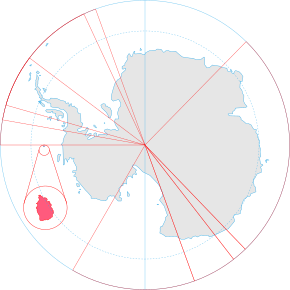Our website is made possible by displaying online advertisements to our visitors.
Please consider supporting us by disabling your ad blocker.
Peter I Island
Peter I Island | |
|---|---|
 December 2022 satellite image of Peter I Island | |
 Location of Peter I Island (circled in red, relative to Antarctica) | |
| Claimed by Norway | 6 March 1931 |
| Antarctic Treaty | 23 June 1961 |
| Area | |
• Total | 154 km2 (59 sq mi) |
| 95% | |
| Highest elevation | 1,640 m (5,380 ft) |
| ISO 3166 code | AQ |
| Internet TLD | |
Peter I Island (Norwegian: Peter I Øy)[1] is an uninhabited volcanic island in the Bellingshausen Sea, 450 kilometres (240 nmi) from continental Antarctica. It is claimed as a dependency of Norway and, along with Bouvet Island and Queen Maud Land, composes one of the three Norwegian dependent territories in the Antarctic and Subantarctic. The island measures approximately 11 by 19 kilometres (7 by 12 mi), with an area of 156 km2 (60 sq mi); its highest point is the ultra-prominent, 1,640-metre-tall (5,380 ft) Lars Christensen Peak. Nearly all the island is covered by a glacier, and it is surrounded most of the year by pack ice, making it inaccessible during these times. There is little vertebrate animal life on the island, apart from some seabirds and seals.
The island was first sighted by Fabian Gottlieb von Bellingshausen on 21 January 1821 and was named after Peter I of Russia. Not until 2 February 1929 did anyone set foot on the island, when Nils Larsen and Ola Olstad's Second Norvegia Expedition, financed by Lars Christensen, was successful. They claimed it for Norway, which annexed it in 1931 and made it a dependency in 1933. The next landing occurred in 1948, and the island has been subject to some scientific research and a limited amount of tourism. The island became subject to the Antarctic Treaty in 1961. Since 1987, there has been an automated meteorological station on the island. Three amateur radio DX-peditions have visited the island, and there are sporadic landings by tourists.
- ^ "Peter I Øy". Norwegian Climate and Pollution Agency. Archived from the original on 14 May 2011. Retrieved 29 August 2011.
Previous Page Next Page


